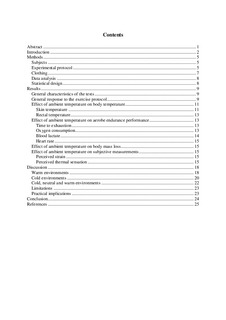Effect of ambient temperature on endurance performance in cross country skiers.
Master thesis
Permanent lenke
http://hdl.handle.net/11250/271479Utgivelsesdato
2010Metadata
Vis full innførselSamlinger
Sammendrag
Purpose: The purpose of this study was to investigate the effects of exposure to cold and warm environments on performance-related variables in cross country skiers, wearing standardized skiing clothing. We hypothesized that reducing ambient temperature, skin temperatures will gradually decrease despite increasing core temperature. In addition we hypothesized that the optimal ambient temperature for aerobe endurance performance with the existing cross country skiing suit would be at temperatures around 0 ºC.
Methods: Nine highly trained male endurance athletes performed one pre-test at 20 °C (±0.1) and six main tests under controlled ambient temperatures at -14 °C (±0.2), -9 °C (±0.1), -4 °C (±0.1), 1 °C (±0.2), 10 °C (±0.1) and 20°C (±0.1). Tests consisted of running on a treadmill with an inclination of 10.5% and a wind speed at 5.5 m·sek-1. The exercise protocol consisted of a 10 min warm up phase (60% of maximal oxygen consumption), a submaximal phase with four steps of 5 minutes with an intensity between 67- 91% of maximal oxygen consumption, and a maximal phase, running to exhaustion. Skin temperatures, rectal temperature, time to exhaustion, oxygen consumption, heart rate, blood lactate, loss of body mass, perceived strain and perceived thermal sensation were measured during the tests.
Results: Mean skin temperature decreased significantly with reduced ambient temperatures, despite an increase in rectal temperature. Time to exhaustion was significantly longer at -4 °C and 1°C than at -14 °C, 10 °C and 20 °C. Running speed at lactate threshold was significantly higher at -4 °C than at -9 °C, 10 °C and 20°C. Submaximal oxygen consumption was significantly higher at 10 °C and 20 °C than the other ambient conditions, but no significant difference in VO2max between the ambient conditions were found.
Conclusion: The results of the present study indicates an optimal aerobe endurance performance with the existing cross country skiing suit at -4 ºC and 1 ºC. At higher (10°C and 20°C) and lower (-14 °C and -9 °C) ambient temperatures the aerobe endurance performance was impaired.
